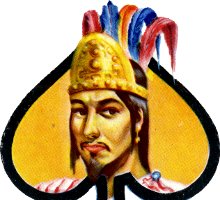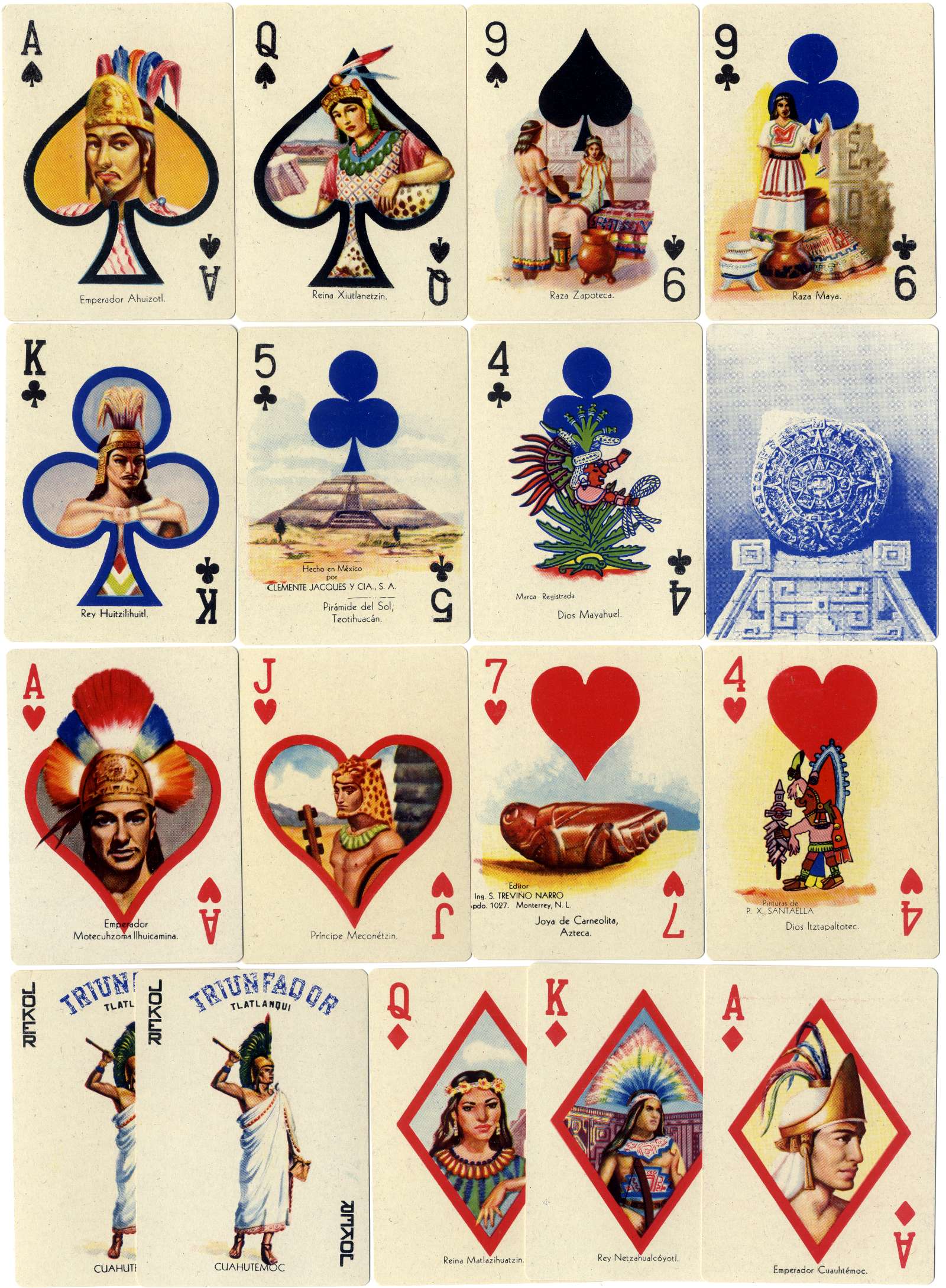Baraja Cuauhtémoc
Baraja Cuauhtémoc published by Treviño Narro, Monterrey, Mexico Original artwork by P. X. Santaella featuring Aztec and other important pre-Columbian cultures.

Baraja Cuauhtémoc
published by Treviño Narro, Monterrey
Printed by Clemente Jacques y Cia S.A. c.1950
Original artwork by P. X. Santaella featuring Aztec and other important pre-Columbian cultures. The Ace of Spades features Emperor Ahuizotl (1486-1502). The 5 of clubs (second row) shows the Teotihuacán Sun Pyramid, one of the masterpieces of Mexican architecture, V century, and also the name of the manufacturer, Clemente Jacques y Cia, S.A.

Above: Aztec Playing cards - Baraja Cuauhtémoc - published by Treviño Narro, Monterrey, Mexico, c.1950 based on original paintings by P. X. Santaella, whose name appears on the Four of Hearts. Printed in Mexico by Clemente Jacques y Cia, S.A. Presented in single boxes or double pack 'Canasta' boxed sets with matching backs and 20-page leaflet describing the images on the cards. The Ace of Diamonds shows Emperor Cuauhtémoc ('Falling Eagle', 1495-1525); Queen of Spades Queen Xiutlanetzin who had 100 slaves to attend to her needs. The Jokers depict Tlatlanqui, signifying 'Victorious' and who represents the last of the Aztec monarchs.
See also: Mexico homepage • Naipe Victoria • Naipes Nacionales • Souvenir of Mexico • El Fenix • Las Dos Torres • Cassino • El León • Gallo • Baraja Taurina • Aeronaves de Mexico • Anonymous Manufacturers • La Cubana • Camacho • Maya Playing Cards • Soberano • Editorial RAF • Pierrot • Acapulco Souvenir • Pronaco • Juegos y Fichas • Naipes Gacela • Bartolo Borrego • Munguia

By Simon Wintle
Member since February 01, 1996
I am the founder of The World of Playing Cards (est. 1996), a website dedicated to the history, artistry and cultural significance of playing cards and tarot. Over the years I have researched various areas of the subject, acquired and traded collections and contributed as a committee member of the IPCS and graphics editor of The Playing-Card journal. Having lived in Chile, England, Wales, and now Spain, these experiences have shaped my work and passion for playing cards. Amongst my achievements is producing a limited-edition replica of a 17th-century English pack using woodblocks and stencils—a labour of love. Today, the World of Playing Cards is a global collaborative project, with my son Adam serving as the technical driving force behind its development. His innovative efforts have helped shape the site into the thriving hub it is today. You are warmly invited to become a contributor and share your enthusiasm.
Related Articles

Modern Swiss-German Pattern (carta.media)
Modernizing tradition: balancing clarity and continuity in regional card design.

Tactics Design
Late modernist Japanese playing cards designed by Masayoshi Nakajo for Tactics Design.

The Decadent Deck
Studies in the eroticism of the female body by Inge Clayton.

Historic Shakespeare
“Historic Shakespeare” playing cards featuring Shakespearean characters by Chas Goodall & Son.

Sunday Night / Nichiyoubi no Yoru
An irreverent, avant-garde deck unofficially titled "Nichiyoubi no Yoru" (Sunday Night), designed by...

Emilio Tadini playing cards
Beautiful dreamlike playing card designs by Emilio Tadini.

Zürcher Festspiel 1903
Swiss-suited pack designed by Robert Hardmeyer featuring figures from art and politics.

Tarot de Valverde de la Vera
A series of 24 surrealist engravings by Mexican artist Claudio Favier in which archetypal Tarot alle...

Never Mind the Belote
Limited edition Belote pack with designs by a collective of 24 street artists.

Visite Mexico
Promoting Mexican tourism with 54 different photographs in full colour.

Playing card designs by Franz Exler
Reconstruction of playing cards from the original 1903 designs.

MITSCHKAtzen
Clever cat designs by the Austrian artist and illustrator Willi Mitschka.

22 Pittori in 22 Arcani
Collaborative Tarot with contributions from 22 different Italian artists including Menegazzi and Tav...

Whist by Ditha Moser
Ditha Moser created this minimalist Whist deck in 1905, in the style of the Vienna Secession art mov...

Keith Haring playing cards
Energetic graffiti images by the American artist Keith Haring.

Tarot Baraja Egipcia
Curious Tarot with Egyptian-style trumps issued by Franco Mora Ruiz from Mexico.
Most Popular
Our top articles from the past 28 days

